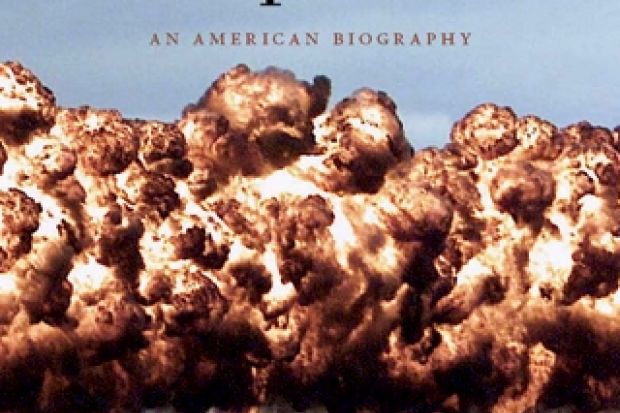We have become accustomed to books dealing with a single familiar commodity: salt, cod, sugar, oil. Napalm: An American Biography is also a history of a product. It has been in use by Americans at war since the 1940s. However, public awareness of its existence was limited before the Vietnam War made it notorious. Robert Neer begins his history with an invocation of one of the most painful of that war’s iconic photographs: a naked child, Kim Phuc, screaming in pain, running down a highway. “Napalm had caught her as she ran, and splattered over the upper left side of her body. It carbonized her pony tail, and seared her neck and left arm.” Over a third of her body had been burned raw and her right palm was “an open wound from where she had smeared burning gel in an effort to get it off her arm”.
Neer then introduces the scientists who invented the weapon, including the distinguished professor of organic chemistry, Louis Fieser, who tested a 70lb napalm bomb on Harvard University’s soccer field in 1940 and became an early recruit to the National Defense Research Committee, which linked the academy to the military and industry. Fieser and a team of scientists continued to work on an effective delivery system for napalm, at one point experimenting with the use of thousands of hibernating bats, each equipped with a tiny napalm bomb.
Towards the end of the Second World War, napalm was used both in flamethrowers and aerial bombs, achieving its greatest “success” in the incineration of major Japanese cities in the spring of 1945. A professor of medicine wandering through the ruins of Tokyo found there “was no one to rescue. If you touched one of the roasted bodies the flesh would crumble in your hand. Humanity was reduced to its chemical properties.” Updraughts from the fires “brought with them a sickening odor”, an American pilot remembered, “an odor that I will never be able to get completely out of my nostrils - the smell of roasting human flesh. I later learned that some pilots and crewmen gagged and vomited in reaction to this stench, and that a few had passed out.”
In post-1945 wars of decolonisation and counter-insurgency, napalm again proved its efficacy. In Korea, the US dropped twice as much napalm as it had on Japan: 32,357 tons. But the apogee of its use and the beginning of a remarkable struggle against it occurred during the Vietnam War. Between 1963 and 1973, 388,000 tons of napalm were dropped on Indochina. Press reports of its impact were accompanied by praise for its excellence as a weapon and the insistence that it was only ever used on “clearly identified military targets” - although of course accidents did happen.
Unconvinced, in 1965 an anti-war group in California began a campaign against a local manufacturer. Increasingly, attention focused on the major producer of napalm, Dow Chemical, and protests took more active forms, from blocking Dow recruiters on campuses across the country, to using homemade napalm in an exemplary action - burning records in a local draft board. Meanwhile, vivid reporting on the impact of napalm on people, with accompanying visuals, made the subject of the struggle more visible. By 1969, Dow got out of the business, although there were others to take its place.
Neer’s biography covers the post-Vietnam years of napalm, its appearance in song and story (the scabrous military call-and-response Napalm Sticks to Kids, the film Apocalypse Now), US resistance to international efforts to ban its use (overcome finally in 2008, although with reservations) and, albeit with a name change, its ongoing use in the war in Iraq. Although it has been used by other countries, napalm has “burned more people in the name of the United States, more widely, and over a longer period of time, than any other country”, Neer says. He ends his disturbing book where he began, with the words of a grown-up Kim Phuc, able to describe the ongoing pain of her days while at the same time forgiving those responsible for it. I doubt most readers will feel quite so generous.
The book is lacking in one regard, but that is the fault of the publisher and not the author: there is no bibliography. However, Neer has provided a remedy in the form of a website where the reader can find one, along with supplementary notes, photographs and videos.
Napalm: An American Biography
By Robert M. Neer
Harvard University Press, 352pp, £22.95
ISBN 9780674073012 and 9780674075450 (e-book)
Published 25 April 2013
Register to continue
Why register?
- Registration is free and only takes a moment
- Once registered, you can read 3 articles a month
- Sign up for our newsletter
Subscribe
Or subscribe for unlimited access to:
- Unlimited access to news, views, insights & reviews
- Digital editions
- Digital access to THE’s university and college rankings analysis
Already registered or a current subscriber? Login




